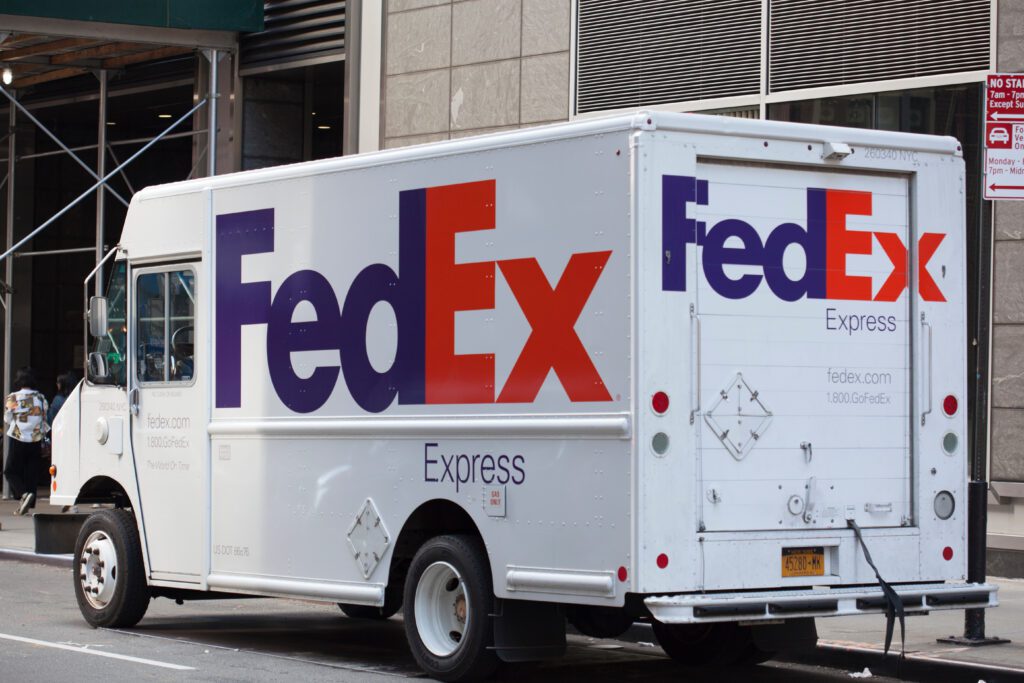FedEx “delivered a strong finish” to its fiscal 2025, growing revenue and operating income in its Q4, CEO Raj Subramaniam told investors on the carrier’s quarterly earnings call.
Subramaniam said FedEx “flexed” its network to match demand as tariffs impacted shipments. It reduced capacity on its Asia-to-Americas lane by more than 35% in the first week of May compared to April. Additionally, it added a direct flight from Singapore to the U.S. to “more efficiently capture increased demand out of Southeast Asia,” he said.
The end of fiscal 2025 also marks two straight years that FedEx has reduced its cost per package in Europe, according to Subramaniam.
Close to half of the Top 2000 retailers in North America use FedEx as a shipping carrier, according to Digital Commerce 360 data. The Top 2000 refers to North America’s largest online retailers by annual ecommerce sales. In 2024, 939 online retailers in the Top 2000 Database used FedEx as a shipping carrier.
FedEx revenue in Q4
In Q4, FedEx revenue grew 1% year over year. At the same time, it grew its adjusted operating income 9%.
“We achieved this result in a weak demand environment with growth largely drawn by our deferred services,” Subramaniam told investors.
That led FedEx to finish its fiscal 2025 with $87.9 billion in revenue, up from $87.7 billion the prior year. It also came amid a $120 million headwind from the U.S. Postal Service (USPS) selecting the United Parcel Service (UPS) for its new air cargo contract, which went into effect Sept. 30, 2024. FedEx had previously held that contract for more than 20 years.
U.S. domestic volumes “help up well throughout the quarter,” according to chief customer officer Brie Carere. Growth in domestic volumes accelerated in late April and May, she said, when many Americans were bracing for tariffs to kick in.
Customer concerns increased following the April 2 tariff announcement, and as a result, volumes softened, Carere said.
“In early May, upon tariff implementation, China to U.S. volumes deteriorated sharply and remained weak throughout the rest of the quarter,” Carere told investors. “Our international export revenue was flat, reflecting the tariff-related impact on our Trans-Pacific trade lane.”
Year-over-year declines in FedEx’s Freight segment “moderated sequentially” in Q4, she said. Average daily shipments decreased 1% year over year in the quarter compared to a 5% decrease in Q3 and 8% drop in Q2.
FedEx has also increased the revenue per pound for parcels going through its global air freight, Carere said. However, total revenue per shipment declined 1%. Carere attributed that to a lower fuel surcharge and lower weight per shipment.
FedEx B2B volume
Consistent with trends over the last several quarters, Subramaniam said, FedEx’s higher-margin B2B volumes remained pressured in Q4.
“That said, we are encouraged by the sequential improvement of FedEx Freight and our ability to protect profitability with an operating margin of 20.8% in Q4,” he said. “The trade-related events of the fourth quarter showcased our ability to leverage both the scale and the flexibility of our unrivaled global network supported by insights from the vast amounts of data we collect.”
Carere called FedEx’s emphasis on B2B, small and medium-sized businesses, Europe and air freight “a deliberate approach to capitalize on high-margin market opportunities.” At the same time, FedEx is working on diversifying its revenue streams globally, she said.
Among those revenue streams is health care-related revenue. FedEx ended its fiscal 2025 with $9 billion in health care-related revenue, which Carere said drove growth in U.S. priority volumes.
Looking forward to Q1, FedEx expects revenue to be in the range of flat to 2% growth. That includes a $170 million adjusted operating income headwind from international export due to global trade policy impacts, chief financial officer John Dietrich said.
Passing of founder Frederick W. Smith
FedEx founder, executive chairman and longtime CEO Frederick Wallace Smith has died from natural causes on June 21, the company shared. He was 80 years old.
Under his leadership, FedEx “grew from a small startup into a multinational corporation that redefined global commerce,” the company write in a statement.
Subramaniam told investors it felt strange to be with them so soon after his passing — the carrier’s quarterly earnings call was just three days later.
“And it is difficult to put into words the tremendous loss felt by all who knew Frederick W. Smith,” Subramaniam said. “But Fred was a man grounded by a mission, and he would tell us to say, ‘focus on the business and keep marching forward.’ And so we will do just that.”
He described Smith as “more than a business leader” and “a visionary who revolutionized the delivery industry.” Subramaniam said Smith was relentless in his pursuit of excellence and his commitment to connect people and possibilities.
“I will miss his strategic counsel, impeccable character and sharp wit,” he said. “He taught me that leadership is about service and not titles. He challenged me to think bigger, act bolder and always, always put our people and our customers at the center of everything we do.”
Percentage changes may not align exactly with dollar figures due to rounding. Check back for more earnings reports. Here’s last quarter’s article on FedEx revenue.
Do you rank in our databases?
Submit your data and we’ll see where you fit in our next ranking update.
Sign up
Stay on top of the latest developments in the online retail industry. Sign up for a complimentary subscription to Digital Commerce 360 Retail News. Follow us on LinkedIn, X (formerly Twitter), Facebook and YouTube. Be the first to know when Digital Commerce 360 publishes news content.
